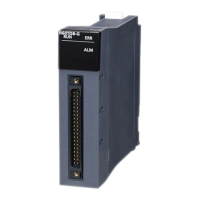422
26 REDUNDANT FUNCTION
26.6 Program Execution in Both Systems
Precautions
The following lists the precautions for using a program executed in both systems.
Item Description Reference
Program execution time Set a program execution time of the standby system to be shorter than that of the control system.
In a redundant system with redundant extension base unit, set a program execution time of the
standby system to be within 200ms.
Page 423 Program
execution time
Constant scan The constant scan is invalid in the standby system when the redundant system is in backup mode.
Time required for system
switching
If system switching is attempted to be performed while a program executed in both systems is
being executed, the system is switched after the END instruction is completed. Thus, a time
required for system switching may be extended.
Program
execution
type
Execution type
change
The execution type of a program executed in both systems is not taken over at system switching.
Even if the systems are switched after the execution type is changed by using a program control
instruction (PSCAN(P), PSTOP(P), or POFF(P) instruction) on the old control system, the program
is executed on the new control system with the execution type of the old standby system.
Initial execution
type
When the systems are switched while an initial execution type program set as a both systems
execution program is being executed, the initial execution type program is executed twice in the
CPU module of the new control system.
The old standby system is switched to the new control system after the initial execution type
program has been completed, and then the initial execution type program is executed again.
Event execution
type
In a redundant system with redundant extension base unit, an event execution type program in
which the trigger type is set to "ON of bit data (TRUE)" and the module access device (Un\G) of
the module on an extension base unit is specified cannot be executed by the standby system
when the redundant system is in separate mode. Therefore, be careful when performing system
maintenance in separate mode.
SFC program The SFC program cannot be set to be executed in both systems.
Interrupt disabled or enabled
state
The control system and standby system have individual interrupt disabled or enabled state
because the states are not transferred.
Tracking transfer Do not set global devices used in a program executed in both systems as a tracking transfer
target. When using labels in a program executed in both systems, use local labels. When using
FBs in a program executed in both systems, use local FBs.
Page 423 Tracking
transfer
Device Timer (T) When the control system is switched to the standby system, the current value of the timer is not
updated in the first scan of the new standby system and a timeout does not occur. As a result, an
error of the time required for system switching + one scan is produced at system switching.
Long timer (LT)
and long retentive
timer (LST)
When the long timer (LT) or long retentive timer (LST) is used in the standby system, time is not
measured and a timeout does not occur.
After the standby system has been switched to the control system, the long timer (LT) or long
retentive timer (LST) is started up. To measure time in the standby system, use the timer (T).
Interrupt pointer (I) The interrupt pointer (I) cannot be used for the standby system in backup mode.
Buffer memory address In a redundant system with redundant extension base unit, do not access the buffer memory of the
module on the extension base unit from a program executed in the standby system in separate
mode or in a program executed in both systems using instructions or the module access device. If
the buffer memory is accessed from the standby system, a stop error occurs. (When "Continue" is
selected in the operation error in the RAS setting for the CPU parameter, the error can be set as a
continuation error.)
The error can be also set as non-processing with SM1762 (Operation setting for access from the
standby system to the extension base unit).
Restricted instructions Some instructions have restrictions when they are used in a program executed in both systems. Page 424 Restricted
instructions
Standard
function
block
TIMER__M When the control system is switched to the standby system, the current value of the timer is not
updated in the first scan of the new standby system and a timeout does not occur. As a result, an
error of the time required for system switching + one scan is produced at system switching.
TP(_E), TON(_E),
TOF(_E)
When these function blocks are used in the standby system, time is not measured and a timeout
does not occur.
After the standby system has been switched to the control system, TP(_E), TON(_E), or TOF(_E)
are started up.
Ethernet Socket
communications
When data is sent to the Ethernet-equipped module of the standby system, the data receive
processing is not performed because the Ethernet-equipped module discards the received data.
MELSEC iQ-R
Ethernet User's
Manual (Application)
Communications
using the fixed
buffer

